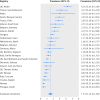Prevalence of microcephaly in Europe: population based study
- PMID: 27623840
- PMCID: PMC5021822
- DOI: 10.1136/bmj.i4721
Prevalence of microcephaly in Europe: population based study
Abstract
Objectives: To provide contemporary estimates of the prevalence of microcephaly in Europe, determine if the diagnosis of microcephaly is consistent across Europe, and evaluate whether changes in prevalence would be detected using the current European surveillance performed by EUROCAT (the European Surveillance of Congenital Anomalies).
Design: Questionnaire and population based observational study.
Setting: 24 EUROCAT registries covering 570 000 births annually in 15 countries.
Participants: Cases of microcephaly not associated with a genetic condition among live births, fetal deaths from 20 weeks' gestation, and terminations of pregnancy for fetal anomaly at any gestation.
Main outcome measures: Prevalence of microcephaly (1 Jan 2003-31 Dec 2012) analysed with random effects Poisson regression models to account for heterogeneity across registries.
Results: 16 registries responded to the questionnaire, of which 44% (7/16) used the EUROCAT definition of microcephaly (a reduction in the size of the brain with a skull circumference more than 3 SD below the mean for sex, age, and ethnic origin), 19% (3/16) used a 2 SD cut off, 31% (5/16) were reliant on the criteria used by individual clinicians, and one changed criteria between 2003 and 2012. Prevalence of microcephaly in Europe was 1.53 (95% confidence interval 1.16 to 1.96) per 10 000 births, with registries varying from 0.4 (0.2 to 0.7) to 4.3 (3.6 to 5.0) per 10 000 (χ(2)=338, df=23, I(2)=93%). Registries with a 3 SD cut off reported a prevalence of 1.74 per 10 000 (0.86 to 2.93) compared with those with the less stringent 2 SD cut off of 1.21 per 10 000 (0.21 to 2.93). The prevalence of microcephaly would need to increase in one year by over 35% in Europe or by over 300% in a single registry to reach statistical significance (P<0.01).
Conclusions: EUROCAT could detect increases in the prevalence of microcephaly from the Zika virus of a similar magnitude to those observed in Brazil. Because of the rarity of microcephaly and discrepant diagnostic criteria, however, the smaller increases expected in Europe would probably not be detected. Clear diagnostic criteria for microcephaly must be adopted across Europe.
Published by the BMJ Publishing Group Limited. For permission to use (where not already granted under a licence) please go to http://group.bmj.com/group/rights-licensing/permissions.
Conflict of interest statement
All authors have completed the ICMJE uniform disclosure form at www.icmje.org/coi_disclosure.pdf and declare: no support from any organisation for the submitted work; no financial relationships with any organisations that might have an interest in the submitted work in the previous three years; no other relationships or activities that could appear to have influenced the submitted work. All authors had full access to all of the data in the study and can take responsibility for the integrity of the data and the accuracy of the data analysis.
Figures
References
-
- Dolk H. The predictive value of microcephaly during the first year of life for mental retardation at seven years. Dev Med Child Neurol 1991;33:974-83. 10.1111/j.1469-8749.1991.tb14813.x pmid:1743426. - DOI - PubMed
-
- von der Hagen M, Pivarcsi M, Liebe J, et al. Diagnostic approach to microcephaly in childhood: a two-center study and review of the literature. Dev Med Child Neurol 2014;56:732-41.. 10.1111/dmcn.12425 pmid:24617602. - DOI - PubMed
-
- Schuler-Faccini L, Ribeiro EM, Feitosa IM, et al. Brazilian Medical Genetics Society–Zika Embryopathy Task Force. Possible association between Zika virus infection and microcephaly — Brazil, 2015. MMWR Morb Mortal Wkly Rep 2016;65:59-62.. 10.15585/mmwr.mm6503e2 pmid:26820244. - DOI - PubMed
-
- Rasmussen SA, Jamieson DJ, Honein MA, Petersen LR. Zika virus and birth defects--reviewing the evidence for causality. N Engl J Med 2016;374:1981-7. 10.1056/NEJMsr1604338 pmid:27074377. - DOI - PubMed
-
- Mysorekar IU, Diamond MS. Modeling Zika Virus Infection in Pregnancy. N Engl J Med 2016;375:481-4.. 10.1056/NEJMcibr1605445 pmid:27433842. - DOI - PubMed
Publication types
MeSH terms
Grants and funding
LinkOut - more resources
Full Text Sources
Other Literature Sources
Research Materials
Miscellaneous


